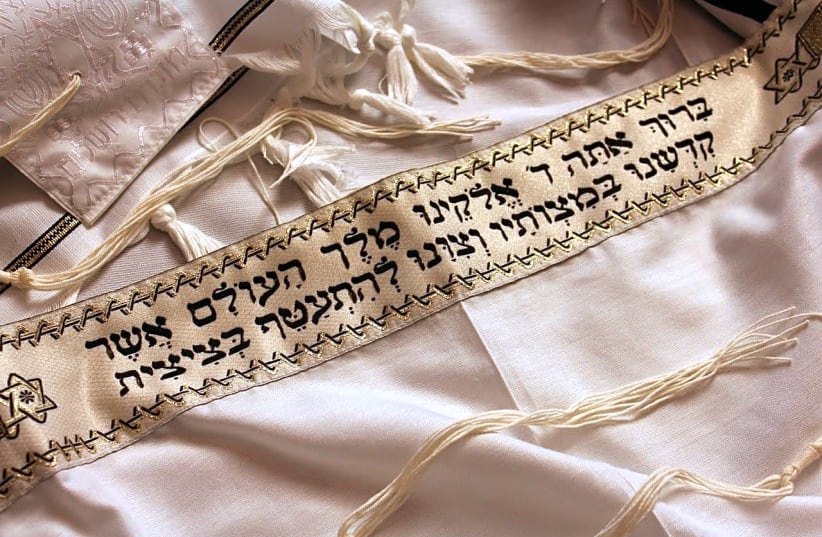In terms of its form, the tallit is a shawl made from wool, cotton, or even silk on a rare occasion. One of the most characteristic features of the item is the borderline fringes that are knotted and twined. These fringes, attached to the four corners of the tallit, are known as tzitzit. According to the Encyclopaedia Judaica, the tallit was a rectangular mantle similar to a blanket that men wore in ancient times. White is the most common color used.
To be more accurate, there are two types of tallits. The smaller version, or tallit katan, is an item that Jews wear either above or under their clothing. A common name for this small tallit is the tzitzit. The larger type of tallit, and the main subject of this article, is known as the tallit gadol in full. This prayer shawl is placed above the outer clothing when it is time for morning prayers and during the prayers offered on the Jewish holiday of Yom Kippur.
The wearing of the tallit can be traced back to the Hebrew Bible. While it was not expressly commanded that people wear a tallit or unique prayer shawl, the text assumed that people covered themselves during prayer. In the book of Numbers 15 verse 38, the instruction is given for the Israelites to attach fringes to the corners of their prayer cloth coverings. In Deuteronomy 22, verse 12, there is a related command—this time, it is for the children of Israel to add twisted cords to the four corners of their prayer coverings.
During prayer, the wearer usually drapes the tallit over their shoulders. Some people choose to cover their entire heads with it. The Torah does call for this covering of the head in particular parts of some services.
From the Hebrew Bible mentions of a prayer shawl with fringes and knots, a standard format was developed, and this has been mainly influenced by culture and rabbinic sects, post-biblically. Different communities and branches of Jews follow different customs with regard to the specifics of the tallit form and design. The number of knots in the fringes, for example, is something that varies between communities.
Despite the variations in the nature and layout of the tallit gadol and the limited instructions in the biblical texts concerning this, the Bible is clear on the whole reason for the fringes of the shawl. These tzitzit are the subject of the biblical text from the book of Numbers 15 verses 39-40. The purpose of the unique edges is for the Jews to look at them and recall the commandments of God, and then go on to do them. The tzitzit serve as a visual reminder to obey the law and not pursue selfish desires of the heart and eyes and so fall away. The objective is holy before God.
In earlier times, the materials of choice for the shawl were wool or linen. Many interpreted the reference to a garment in the law as referencing garments made of either wool or linen. There is still some debate on the material to be used, with many vouching for wool. There are some reservations around using a mixture of wool and linen because the combination of these materials was forbidden. One of the two exceptions is for tzitzit garments, according to the Hebrew Bible.
If you have ever looked at a tallit or own one yourself, you may have noticed a blue thread in the fringes. This feature is familiar to most of these prayer shawls and is known as a techelet fringe. The inclusion of the blue twine in the tzitzit is by biblical command. There were many years when this thread was omitted, including the centuries from the Israelites’ exile from Israel. Nowadays, and in the last century, the blue techelet has once again become commonplace.
Wearing the tallit is a privilege guided by traditions and protocols. While the smaller shawl, or tallit katan, is worn from the age of preschool, boys usually wear the tallit gadol from bar mitzvah at the age of 13 years. Different traditions do prevail regarding the latter. Men start wearing the tallit from marriage in many Ashkenazi communities, and the shawl can even be given as a wedding gift or as part of the dowry.
The tallit gadol is often a man’s gift to his son, son-in-law, or even his student. Although men and boys traditionally wear the tallit, women today may also wear these prayer shawls, particularly in the non-Orthodox Reform movements, such as the Reform, Karaite, Conservative, and Reconstructionist movements. Prayer shawls are available in the synagogues for guests to use, but many Jews carry their own tallits to the services.
According to rabbinic law, women need not wear a tallit or tzitzit. In contemporary Orthodox Judaism, it is actually forbidden for a woman to wear a tzitzit in public. The movement by the non-Orthodox Jews to have women start wearing tallits as well gained momentum in the 1970s. Distinctly female tallits produced used different materials and colors from the traditional male ones.
Another occasion when you can see a tallit in use is during the Jewish holiday of Simchat Torah. The tallit gadol is spread over the children as a canopy while the Torah-reading ceremony is underway. You can also see this in other services involving the Torah scrolls.
A tallit gadol is an integral part of Jewish prayer. This prayer shawl and its characteristic fringes serve as a reminder to obey God’s commands. With roots in biblical history and despite the diverse applications and interpretations, the tallit serves an essential purpose in the prayer life of Jews.
In collaboration with jewish.shop